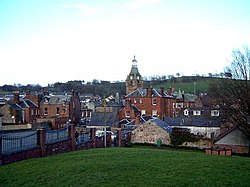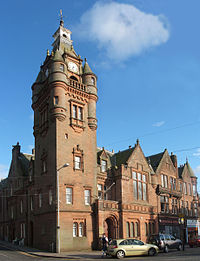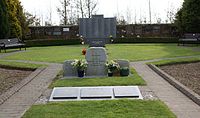Lockerbie
| Lockerbie | |
| Dumfriesshire | |
|---|---|
 Lockerbie | |
| Location | |
| Grid reference: | NY135815 |
| Location: | 55°7’12"N, 3°21’25"W |
| Data | |
| Population: | 4,009 (2001) |
| Post town: | Lockerbie |
| Postcode: | DG11 |
| Dialling code: | 01576 |
| Local Government | |
| Council: | Dumfries and Galloway |
| Parliamentary constituency: |
Dumfriesshire, Clydesdale and Tweeddale |
Lockerbie is a town in Annandale in Dumfriesshire, on the main route between Carlisle and Glasgow. It stands some 20 miles north of Carlisle and 75 miles south of Glasgow. A small town, with a population of just 4,009 at the 2001 census, Lockerbie is has grown from its transport connections. Historically the town has been a trading post for both cattle and sheep. Because of its proximity to the borders, the cattle trade with the counties at the south dominated the local economy for a long time. The town maintains still a sheep market.
Lockerbie has a well developed transport network for a town its size. It lies next to the M74 motorway and has a railway station on the main Glasgow–London West Coast Main Line. Lockerbie's town hall is its most imposing building and is an excellent example of Scottish baronial style, built in the typical local red sandstone. The building looks over a war memorial built after the Second World War, with its characteristic bronze statue of an angel atop a white base with inscriptions.

Dryfesdale Lodge Visitors' Centre
Dryfesdale Lodge Visitors' Centre,[1] formerly a cemetery worker's cottage, was opened on 25 October 2003 after extensive renovation work funded by the Lockerbie Trust. The Lodge's objective is to be a living, growing, flexible facility that can respond to the needs of visitors and the community.
There are two exhibition rooms in the Lodge and also the Dryfesdale Room that is used as a quiet room for visitors to reflect. A permanent exhibition room displays ten history panels depicting Lockerbie's unique past stretching from its pre-historic origins to the 1988 Lockerbie bombing and beyond. Located within the cemetery grounds, just a short walk away, is the Lockerbie Memorial Garden of Remembrance.
As a tribute to the community of Lockerbie, in its short life the centre has already had over 30,000 visitors from home and abroad.
Hallmuir Prisoner of War Camp
About a mile and a half south of Lockerbie along the road to Dalton are the remains of Hallmuir prisoner-of-war camp.[2] After the Second World War this camp housed up to 450[3] Ukrainian volunteers from the Galician Division of the Waffen SS. They built a chapel which remains in use, currently holding Ukrainian services on the first Sunday of every alternate month.
Lockerbie Drama Club
Lockerbie Drama Club was formed before the Second World War by members of local churches. Originally known as Lockerbie Churches Drama Club, plays were performed in the town hall. In 1964 the club acquired land at the corner of Well Street and Well Road, along with a prefab corrugated iron building that had been a workshop in the Technical department at Lockerbie Academy. This building became Lockerbie Little Theatre.[4] Lockerbie Drama Club puts on two plays per year and holds play readings during the summer.[5]
Lockerbie Ice Rink
Located across the road from Lockerbie Academy, it is one of the oldest indoor ice rinks in the country. Built in 1966 it has a long successful history. In curling it has given rise to World and European Champions and Olympians in the adult, senior and junior disciplines. It also provides skating during most weekends. The ice rink is closed between April and September. It has also recently received funding for a new roof.
Lockerbie House
Lockerbie House was built in 1814 for Sir William Douglas, 4th Baronet of Kelhead and Dame Grace Johnstone and their children; Mary, Henry Alexander, William Robert Keith Douglas, Charles Douglas, 6th Marquess of Queensberry and John Douglas, 7th Marquess of Queensberry. It was inhabited at one time by several different members of the Douglas family through the generations. Such family members include both Archibald Douglas, 8th Marquis of Queensberry PC (son of John Douglas) and his wife Caroline Margaret Clayton (daughter of General Sir William Robert Clayton MP) and their children British mountaineer Lord Francis William Bouverie Douglas, Lady Gertrude Georgiana Douglas, John Sholto Douglas, Viscount Drumlanrig and later the 9th Marquess of Queensberry, Clergyman Lord Archibald Edward Douglas and the twins Lord James Douglas and Lady Florence Dixie (who married Sir Alexander Beaumont Churchill Dixie, 11th Baronet.) John Sholto Douglas was a patron of sport and a noted boxing enthusiast. In 1866 he was one of the founders of the Amateur Athletic Club, now the Amateur Athletic Association of England. The following year the Club published a set of twelve rules for conducting boxing matches. The rules had been drawn up by John Graham Chambers but appeared under Queensberry's sponsorship and are universally known as the "Marquess of Queensberry rules". It is thought that such rules were created within the compounds of Lockerbie House, possibly within the room now known as "The Queensbury Dining Room". It is also thought that at one point Oscar Wilde may have also stayed here for a short amount of time due to his affair with John Sholto Douglas's son the author and poet Lord Alfred Bruce Douglas.
Lockerbie House is an important establishment within Lockerbie, in the past having owned most of the land and housing within the town mainly through the Johnstone Baronets and Douglas family. Like much of Lockerbie this Georgian house is built of old red sandstone and contains approx. 40 bedrooms, situated within 78 acres of secluded woodland and gardens, several outbuildings including a gatehouse, a 2-acre walled garden, croquet lawn, orchards, helipad and a hunting dog pen. The property up until recently also possessed a large stable block but that has since been partly converted into a house with the remaining stables used by a local riding school. Due to the vast size of the property it has frequently been used as a county house hotel in order to help pay for its maintenance and/or provide a prosperous business. The house is now owned by outdoor pursuits company Manor Adventure, and serves as a centre for school activity courses and family adventure holidays.[6]
History
Battle of Dryfe Sands
About 3 kilometers to the west of Lockerbie on 7 December 1593, Clan Johnstone fought Clan Maxwell at the Battle of Dryfe Sands. The Johnstones nearly exterminated the Maxwells involved in the battle, leading to the proverbial expression "Lockerbie Lick."
Lockerbie bombing

Lockerbie came to international attention in 1988. On 21 December 1988, Pan Am Flight 103 was blown up in mid-air by a terrorist bomb and fell onto the town. Eleven townsfolk were killed in Sherwood Crescent, where the plane's wings and fuel tanks plummeted in a fiery explosion, destroying several houses and leaving a huge crater, with debris causing damage to a number of buildings nearby. Among the 270 fatalities (259 on the aeroplane and 11 in Lockerbie) were citizens of 21 nations.